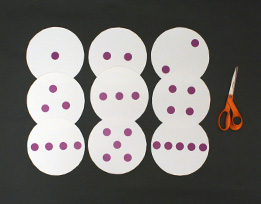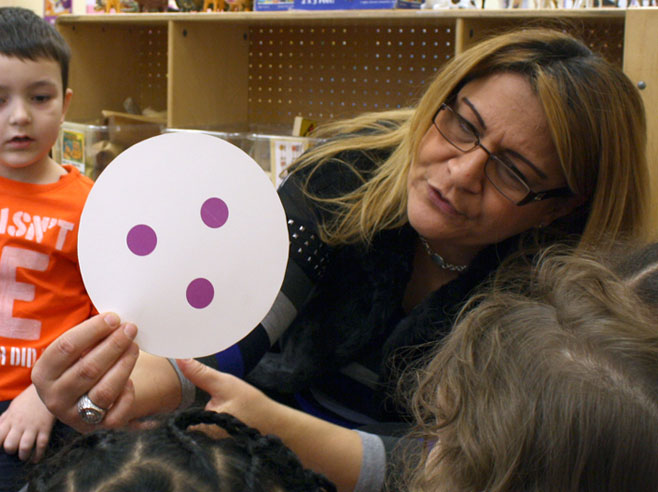Children QUICKLY identify or compare the number of dots on a plate.
Materials

- 9 Dot Plates templates (PDF)
- Cardstock or plain paper
- Scissors
- Optional: 9 white paper plates
- Optional: 29 dark-colored 3/4" round labels (dots)
Preparation
- Print and cut out the Dot Plates Templates (see attached) or make dot plates out of paper plates and dot-shaped labels using the following instructions.
- To make your own dot plates: This set of dot plates are made using nine white paper plates with dot-shaped labels in different arrangements for number sets 1–5. Round plates have the advantage of having no particular orientation, so children can see that a square formation of four dots becomes a diamond formation of four dots when turned 45 degrees. Place the dot-shaped labels on nine paper plates in the same arrangement as on the Dot Plates Templates above.
Directions
This activity can be repeated over several days. Start with the steps 1-6. Then, as children gain familiarity, extend the activity with steps 7-9.
- Tell the children that they will be learning how to recognize and count numbers.
- Hold up one finger for two seconds only and then put your hand down. Alternative: Challenge the children more, and use both hands to show the numbers.
- Ask, How many fingers? Have children hold up the same number of fingers and say the number. Do the same thing with two, three, four, and five fingers.
- Now tell the children that they will do the same thing, only this time with dot plates.
- Make sure the order of the plates is mixed up. Place the plates in your lap so children can’t see the dots. Hold up a dot plate for two seconds only so children can see the dots; then quickly place it back in your lap. Ask the children to show you how many dots were on the plate by holding up that number of fingers or saying the number out loud. Repeat the activity with the rest of the dot plates.
- After you display several plates, ask them to explain how they know what the number is.
- To extend this activity if you have time or on another day, try the following variation: Flash a dot plate showing the triangular pattern of three dots for two seconds only and ask the children, How many? Then, flash a plate showing a straight line of three dots and again ask, How many?
- Then, hold up the two variations of the number 3. Ask, What’s different? What’s the same? Does the number of dots change because they are in different places? How do you know that? Can you show me?
- Repeat the activity. This time use the two variations of the numbers 4 and 5.
Note: Show the dot plate to the children for no longer than two seconds. The goal is for the children to identify the number of dots on the plate without counting.
If some children continue to have difficulty identifying the numbers, work with them in a small group. Start with the lower numbers and have the children count the dots until they can easily recognize each number of dots.

